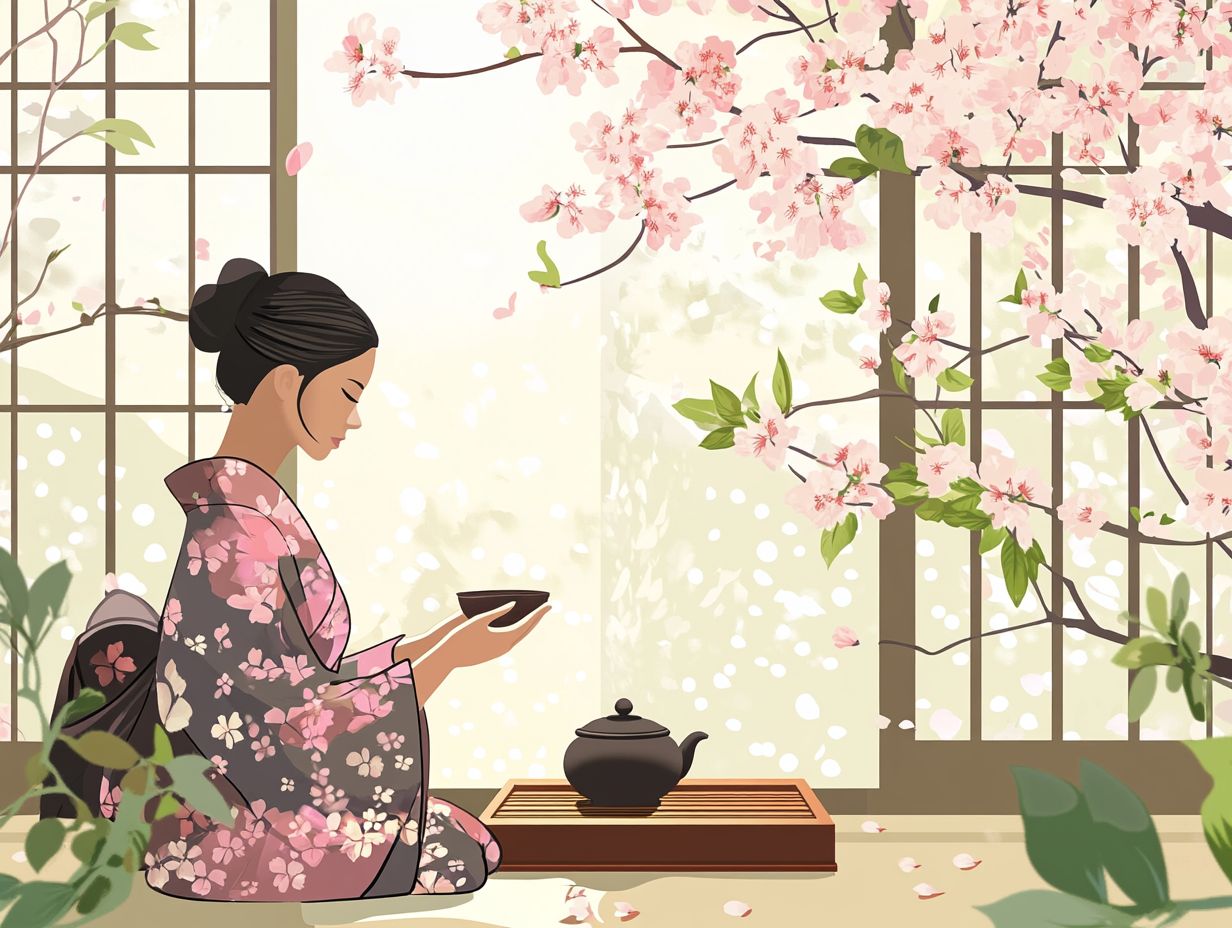A Guide to Common Local Customs in Japan
Understanding the customs and traditions of Japan is essential for anyone seeking to engage meaningfully with this rich culture.
From greeting with a bow to mastering dining etiquette with chopsticks, every facet of Japanese life embodies a profound respect for tradition and social harmony.
Get ready to explore communication styles, appropriate dress codes, and the vibrant celebrations that punctuate the Japanese calendar!
Dive in to discover how these customs shape everyday interactions and contribute to a distinctive cultural identity.
Contents
Key Takeaways:

- Bowing is a common form of respect in Japan, with the depth and duration of the bow conveying different levels of respect.
- Proper use of chopsticks is important in dining etiquette; they should not be used for passing food or pointing at others.
- Traditional clothing, such as the kimono, is still worn for special occasions, and cultural sensitivity should be observed when visiting temples or shrines.
Overview of Customs and Traditions
Japan captivates with its rich tapestry of cultural traditions and customs, each reflecting a unique heritage that beckons your exploration.
From the serene art of the tea ceremony (Sad or Chanoyu) to the spiritual cleansing rituals at Shinto and Buddhist shrines, there s a depth to discover.
Social etiquette is paramount here; proper greetings and thoughtful gift-giving are essential in daily interactions among the Japanese people.
Engaging in communal activities like sumo wrestling showcases Japan’s commitment to tradition and hospitality, fostering a sense of belonging woven into the very fabric of Japanese culture.
Delving into these customs enhances your understanding of the society’s core values and enriches your own experience.
Take the tea ceremony, for example it s not just about sipping tea; it s a meditative practice that emphasizes harmony, respect, purity, and tranquility.
When you visit an onsen (hot spring), you re not merely seeking relaxation; you re partaking in a tradition that underscores the importance of nature and communal bathing in Japanese life.
Being mindful of chopstick etiquette such as avoiding the act of sticking them upright in rice or passing food directly from one set of chopsticks to another reflects a deeper cultural awareness and respect for these cherished traditions.
Engaging with such customs transforms your travel into a meaningful journey, allowing you to immerse yourself in a realm where every gesture and ritual resonates with profound significance.
Greetings and Communication
In Japan, greetings transcend mere formality; they encapsulate a profound sense of respect and are intricately woven into the fabric of etiquette traditions.
The act of bowing, for instance, conveys varying degrees of respect, tailored to the specific context and social hierarchy.
Each nuanced gesture speaks volumes about one s awareness of cultural norms and the importance of relationships.
Bowing and Other Forms of Respect
Bowing in Japan is an essential element of communication, functioning as a gesture of respect that varies in depth and duration based on the situation and the relationship between the individuals involved.
This custom conveys politeness and also signifies humility, gratitude, and an awareness of social hierarchies.
You ll encounter several types of bows, each with its own significance; for instance, a slight bow of about 15 degrees is perfect for casual greetings, while a deeper bow at 30 degrees expresses a greater level of respect or an apology.
In more formal contexts, such as business meetings or when visiting a shrine, a profound bow at 45 degrees may be the appropriate gesture.
By understanding when to employ these varying forms of bowing, you can enhance your interpersonal interactions and gain insight into the rich traditions of etiquette that are intricately woven into Japanese culture.
Explore these customs actively and experience the beauty of Japan s traditions.
Verbal and Nonverbal Communication
Verbal and nonverbal communication in Japan is paramount for conveying messages and emotions. Understanding context, tone, and body language is essential for effective interaction.
In this distinctive cultural landscape, individuals often rely on indirect expressions to communicate their thoughts and feelings. They prefer subtle hints over direct statements; for example, a casual “maybe” might signal a polite refusal, reflecting cultural emphasis on harmony instead of bluntness.
Gestures also carry profound significance. A slight bow can express respect or gratitude, steeped in centuries of tradition.
Silence is valued in Japanese communication. It serves as a valuable space for reflection and depth, allowing you to convey emotions without uttering a word.
These rich layers of interaction beautifully resonate with Japan’s cultural traditions, highlighting ideals of respect, humility, and social cohesion.
Dining Etiquette

Dining etiquette in Japan is not just about eating it’s a rich tradition waiting to be explored! Before you begin your meal, you should say “Itadakimasu,” which expresses gratitude for the food and those who prepared it.
After enjoying your meal, saying “Gochisosama” honors the experience. These rituals showcase the cultural values of gratitude and respect that permeate Japanese society.
Table Manners and Customs
Table manners in Japan reflect a profound respect for the dining experience. Specific customs dictate everything from seating arrangements to how food is consumed.
As you enter a traditional Japanese setting, you will notice clear seating distinctions, often determined by status or age. This reinforces social hierarchies.
You ll likely sit on tatami mats, which are woven straw mats used for flooring, either kneeling or seated cross-legged gestures that embody humility.
Resting your chopsticks properly on a designated holder is a hallmark of good manners.
The presentation of food is also paramount. Elaborate plating not only pleases the eye but elevates the overall sensory experience.
These intricate customs enrich your meal, immersing you in a tapestry of culture that illustrates the artistry and philosophy of Japanese cuisine.
Proper Use of Chopsticks
Proper use of chopsticks is a crucial aspect of dining etiquette in Japan. Specific rules dictate how you should handle them while enjoying traditional dishes.
Mastering this skill elevates your dining experience and shows respect for the food and its cultural significance. It’s vital to hold the chopsticks correctly grasp them about a third of the way from the top.
Be careful not to stick them upright in a bowl of rice, as this resembles a funeral rite and can be seen as disrespectful.
By adhering to these practices, you engage in a cultural legacy that values mindfulness, or being fully present in the moment, and reverence. This seamlessly integrates your behavior into the rich tapestry of Japanese social values.
Clothing and Appearance
In Japan, clothing and appearance go beyond fashion; they are intricately woven into the fabric of cultural sensitivity.
Traditional garments, such as the Yukata, are worn during festivals and special occasions, showcasing the country’s rich textile heritage.
This deep connection between attire and tradition invites you to appreciate the artistry and significance behind every piece.
Dress Code and Cultural Sensitivity
Understanding the dress code in Japan is essential for locals and visitors alike. It signifies cultural sensitivity and respect for traditions that dictate what s appropriate in various settings.
Dress codes in Japan can vary significantly depending on the occasion, location, and even the season. For formal events like weddings or business meetings, attire typically leans towards the traditional. Men usually wear dark suits, while women opt for elegant kimonos or sophisticated dresses.
On the other hand, casual gatherings offer more relaxed styles. Here, you can wear smart casual attire or even vibrant street fashion, especially in urban areas.
For certain venues, such as temples or upscale restaurants, more conservative attire is often required to align with customs. Dressing appropriately in these situations is not just about fashion; it’s a way to honor the rich cultural landscape that Japan offers.
Traditional Clothing and Accessories

Traditional clothing in Japan, such as the kimono and yukata, showcases centuries of craftsmanship and cultural significance. Each garment features intricate patterns and accessories that tell stories of heritage.
As you explore these garments, you ll uncover deep-rooted traditions and the social status of the wearer, reflecting different eras and seasonal changes. The kimono is ideal for formal events like weddings and tea ceremonies. In contrast, the yukata offers a more casual vibe, perfect for summer festivals.
Don t underestimate the accessories; the obi is a decorative sash, while kanzashi are hair ornaments that elevate the outfit and carry symbolic meanings, representing virtues like beauty and elegance. By appreciating these details, you gain deeper insight into the rich tapestry of Japanese culture.
Cultural Events and Celebrations
Cultural events and celebrations in Japan form a vibrant tapestry of the nation’s rich heritage. Major holidays and festivals beautifully showcase traditional customs, embody community spirit, and reflect a profound connection to both nature and spirituality.
Major Holidays and Festivals
Japan’s major holidays and festivals, like Hanami and Tanabata, are occasions for celebration and profound reflections of cultural traditions and the changing seasons.
These events embody deeply rooted values of respect for nature and community. Take Hanami, for instance this cherry blossom viewing festival marks the arrival of spring. It invites you and your loved ones to gather beneath the blooming sakura trees for picnics, soaking in the fleeting beauty of the blossoms.
Similarly, Tanabata, with its origins in ancient mythology, celebrates the annual reunion of two celestial lovers. Today, people adorn bamboo branches with colorful strips of paper, inscribed with their wishes, adding a vibrant flair to the festivities.
Such celebrations not only bring joy but also strengthen bonds within communities, underscoring the significance of shared experiences in Japanese culture. What part of Japanese culture will you explore next?
Customs and Traditions for Special Occasions
For special occasions in Japan, customs are vital in shaping behaviors and rituals surrounding significant life events like weddings, births, and New Year celebrations.
These practices do more than add flair to the festivities. They resonate with deep-rooted values that emphasize respect, family ties, and harmony within the community.
Take weddings, for instance. The couple typically engages in a ritual called san-san-kudo, where they drink sake from three cups three times. This symbolizes the joining of two families.
When it comes to New Year s celebrations, Japan is full of exciting traditions! One such practice is osechi, a beautifully arranged box of traditional foods that encapsulates hopes for prosperity in the year ahead.
Etiquette is crucial in these celebrations. Displaying good manners reinforces the importance of customs, strengthening the sense of unity and shared values that define Japanese society.
Frequently Asked Questions
What is the significance of bowing in Japan?

Bowing is an important custom in Japanese culture and is used as a form of greeting, showing respect, and expressing gratitude.
Should I take off my shoes when entering someone’s home in Japan?
Yes, it is customary to take off your shoes when entering a home in Japan. Make sure to bring a pair of clean socks to wear inside.
Is it considered rude to be late in Japan?
Yes, punctuality is highly valued in Japan. It is important to arrive on time for meetings, appointments, and social gatherings.
Can I use my chopsticks to eat everything in Japan?
While chopsticks are the main utensil used in Japan, there are certain foods, like sushi and traditional Japanese sweets, that are meant to be eaten with your hands.
Is it appropriate to tip in Japan?
No, tipping is not customary in Japan. It may even be considered rude in some situations. Instead, show your gratitude by saying “arigato” (thank you) or leaving a small gift.
Can I speak loudly in public in Japan?
No, speaking loudly in public is considered impolite in Japan. It is important to be mindful of your volume and try to speak softly in public places.
Want to know more about Japanese customs? Dive into the culture and explore more!






